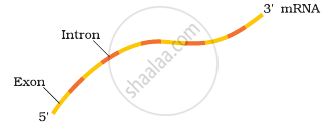Advertisements
Advertisements
Question
Explain the process of making heterogeneous nuclear RNA (hnRNA) into a fully functional mRNA in eukaryotes. Where does this process occur in the cell?
Solution 1
- The process of copying genetic information from one strand of the DNA into RNA is termed transcription.
- A transcription unit in DNA is defined primarily by the three regions in the DNA:
- A Promoter
- The Structural gene
- A Terminator
- RNA polymerase binds to the promoter and initiates transcription (initiation). It uses nucleoside triphosphates as substrate transcription and polymerizes in a template-dependent fashion, following the rule of complementary. It somehow also facilitates opening of the helix and continues elongation. Only a short stretch of RNA remains bound to the enzyme. Once the polymerases reach the terminator region, the nascent RNA falls off, as does the RNA polymerase. This results in the termination of transcription.

An intriguing question is that how is the RNA polymerase able to catalyse all three steps, which are initiation, elongation, and termination. The RNA polymerases is only capable of catalyzing the process of elongation. It associates transiently with the initiation factor (σ) and termination factor (ρ) to initiate and terminate the transcription, respectively. Association with these factors alters the specificity of the RNA polymerase to either initiate or terminate. - In eukaryotes, the RNA polymerase II transcribes the precursor of mRNA, the heterogeneous nuclear RNA (hnRNA).
A cistron as a segment of DNA coding for a polypeptide, the structural gene in a transcription unit could be said as monocistronic (mostly in eukaryotes.) In eukaryotes, the monocistronic structural genes have interrupted coding sequences; the genes in eukaryotes are split. The coding sequences or expressed sequences are defined as exons. Exons are said to be those sequence that appear in mature or processed RNA. The exons are interrupted by introns. Introns or intervening sequences do not appear in mature or processed RNA. - The second complexity is that the primary transcripts contain both the exons and the introns and are non-functional. Hence, it is subjected to a process called splicing where the introns are removed and exons are joined in a defined order. hnRNA undergoes additional processing claled as capping and tailing. In capping, an unusual nucleotide (methyl guanosine triphosphate) is added to the 5’ - end of hnRNA. In tailing, adenylate residues (200–300) are added at 3’ - end in a template-independent manner. It is the fully processed hnRNA, now called mRNA, that is transported out of the nucleus for translation.
Solution 2
- hnRNA in eukaryotes requires modification to be transformed into functional mRNA. The hnRNA comprises both exons and introns. Exons are functional coding regions, whereas introns are non-functional and non-coding sequences. This hnRNA undergoes processing in which introns are excised and exons are ligated through a mechanism known as splicing.
- The transcribed hnRNA undergoes further processing, known as capping and tailing. Capping involves the addition of methyl guanosine triose phosphate to the 5' end, while tailing entails the incorporation of 200-300 adenylate residues at the 3' end of spliced RNA.
- Eukaryotic cells primarily process hnRNA into mature mRNA within their nucleus. After processing, mRNA is exported from the nucleus to the cytoplasm, where ribosomes transform it into proteins.
Notes
Students can refer to the provided solutions based on their preferred marks.
APPEARS IN
RELATED QUESTIONS
Answer the following question.
Construct and label a transcription unit from which the RNA segment given below has been transcribed. Write the complete name of the enzyme that transcribed this RNA.

The amino acid attaches to the tRNA at its ______.
A special feature of viruses is that they:
Which of the following pair lack the unit membrane?
Sigma factor is a component of ______.
The exon part of mRNA has code for ______
Refer the given diagram. What does it represent?

What are the functions of methylated guanasine cap?
Observe the segment of mRNA given below.

(a) Explain and illustrate the steps involved to make fully processed hnRNA?
(b) Gene encoding RNA Polymerase I and III have been affected by mutation in a cell. Explain its impact on the synthesis of a polypeptide, stating the reasons.
- Assertion: Ribosomal RNA is synthesized in the nucleus of the cell.
- Reason: It is translated with the enzyme RNA polymerase III.
